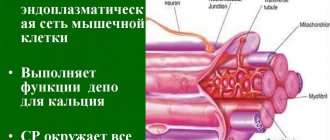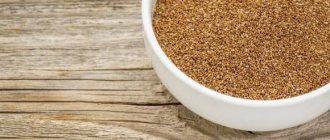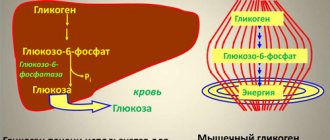What is muscle memory
Know-it-all Wikipedia answers this question this way: “long-term structural changes (restructuring) of muscle and nerve cells that develop under the influence of physical training and ensure rapid restoration of athletic shape after a long rest.”
Find out: What is the “ Role of Minerals for Vitality in the Human Body ”
Unclear? Then let's explain with an example. Imagine that you trained for a long time, got in shape, your muscles grew and developed, and then you stopped training. We got sick, moved to another place, went on maternity leave, and just got tired of studying... And then you decide to return to training again.
So, it turns out that you will get in shape much faster than if you were an absolute beginner.
The muscles seem to restore their previous state based on the information remaining in them. This phenomenon is called muscle memory.
Definition of muscle memory
So what is it? Muscle memory is the ability of the body and organism to remember muscle tone previously developed during training and, after a long break, to restore it as soon as possible. Many famous athletes note that, having abandoned training for a long time, they quickly achieved the desired results by starting the same classes again. Human muscle memory itself is not just an abstract concept, but an effect of the body studied by scientists and psychologists.
How does muscle memory work?
When we load our muscles (whether it's on a weight machine or playing the violin), motor neurons in the right hemisphere of the brain send signals to muscle fibers. In response, the muscles send their signals to the brain. This creates a kind of “bridge”, and the more and more actively we engage, the stronger it becomes.
Therefore, once you learn to skate, you will never forget how, and, having mastered the technique of falling or hitting, if necessary, you will completely automatically reproduce a seemingly forgotten skill. But the mechanism of muscle memory is not limited to neural connections.
Scientists led by Christian Gundersen from the University of Oslo, studying muscle function, made a remarkable discovery. As you know, the cells that make up muscle tissue, or muscle fibers, contain many nuclei. With active loads, the number of nuclei increases, and with them the number of those parts of DNA that are responsible for the synthesis of contractile muscle proteins - actin and myosin - increases.
As a result, muscle mass increases. When we stop training, the body has no need to spend resources on maintaining it, so synthesis slows down and the muscles “deflate.”
But, most importantly, the new nuclei obtained as a result of training do not disappear anywhere! When you load them well again, they will begin synthesis again and return the muscles to their former strength and volume.
Find out about “ Working out in the morning – when it can be detrimental to an athlete’s health ”
Detrained
Detraining is exactly what will happen to us. Our body ALWAYS tries to minimize energy expenditure, because... loves to save money. And as we said before, muscles require a lot of energy!
Imagine a factory that has stopped producing some products. Is it profitable for him to keep and pay wages to those workers who worked on its production? Of course not! These employees are simply fired.
The same thing happens with unused functions of the body, as well as with our muscles... He “dismisses” those of them that he does not need now. What's the point of keeping them?
First, we lose our endurance, then some of our muscle mass disappears, and then our strength begins to decline. Moreover, this process is by no means fast and occurs in stages.
In the first 2 months we lose the most 15-30% of our results. After this, the process slows down. Many athletes retain 30-50% of their trained functions even after a year.
And also, the longer the athlete trained before, the less will be his loss in strength and muscle mass, and the loss will occur much more slowly. The recovery to the previous level will also occur much faster.
If the process of returning to training is carried out correctly, then after 2-3 months you can get back everything you lost! It's all thanks to muscle memory.
First, your strength, coordination and endurance will return. Then muscle mass will return more slowly. The slowest thing will be the return of the strength of the nerve impulse, with the help of which we can contract our muscles much better.
Why and how to develop muscle memory
Gundersen's discovery gives many reasons for optimism and a great incentive for sports and fitness. It turns out that the results you achieved through training are forever imprinted in the memory of your muscles.
By regularly doing physical exercise, we develop muscle memory and create a reserve that we can use until old age.
There was even an experiment done several decades ago. Elderly people 70-80 years old, under the supervision of doctors, were offered to work out with weights. The results were amazing: in a couple of months, the subjects significantly strengthened the muscles of their legs, arms, and abs, and became stronger and more resilient.
However, this does not mean that playing sports can be postponed until retirement. On the contrary, if you want to meet old age vigorous and active, exercise from a young age.
New nuclei in muscle fibers are formed due to the division of satellite cells. With age, these cells lose this ability, and it is unlikely that you will be able to build up muscles, but it is quite possible to regain a decent shape.
Threats from excess: problems with excess weight for our health
About proper nutrition
Of course, it is impossible to list all the products that affect the improvement of muscle mass, but we will not talk about them, but about those that should be avoided, since they negatively affect muscle growth, therefore, do not allow the nuclei to divide and thus negatively affect muscle memory. There are only six of these products:
- Alcohol.
- Chocolate.
- Pastries and cakes.
- Fish caviar.
- Stew.
- Liver.
These products contain huge amounts of cholesterol and inhibit the growth of muscle tissue, and also prevent the nuclei, the very basis of muscle mass, from dividing.
How to use muscle memory
But it turned out that the resumption of active sports promotes nuclear fission. Therefore, by taking breaks from training, you can achieve new, better results. Bodybuilders, for example, are well aware of the “plateau” state, in which, no matter what efforts they make, their mass and strength indicators stand still.
However, a good rest after intense training will help you “reset” and get out of the deadlock. This is true for other species as well. The effectiveness of training decreases when the body gets used to it and begins to use fewer muscle fibers. But if you take a break or change the type of sport or fitness for a while, and then resume exercising at the same intensity, you can make progress.
Does muscle memory work for all types of training?
Yes. Muscles remember the technique of performing any exercise. Having learned to squat correctly with a barbell or swim crawl, even after a ten-year break you will be able to do everything correctly. At least quickly remember how. But still, the effect of muscle memory is most pronounced during strength loads, since nuclear division and the synthesis of contractile hormones are very active.
By the way, if you have trained before, then when you resume training, your muscles and joints will hurt less than those of beginners. And fatigue after training will be less than for beginners.
You see, there are so many reasons to just go to the gym immediately and let your muscles remember more.
Time required to form muscle memory
Muscle memory is an effect that does not appear from the first training. You can count on its acquisition if you have been leading a sporty lifestyle for years. After the first month of training, you should not rush to take a break from training and wait for increased dynamics of muscle mass growth when you return to the gym. Simply put, the longer you have been involved in sports and the shorter the planned break from physical activity, the more expressively you will experience the phenomenon of muscle memory. An important factor in building your ideal body is your diet. A sports lifestyle should be accompanied by a healthy, moderate diet. Otherwise, no physical activity will bring the desired effect in losing weight and creating tone in the main muscle groups. And this factor is doubly important when you return to training after a long break. Perhaps for the quickest effect, it would make sense to supplement sports activities with dietary patterns, swimming, visiting a steam room, more frequent walking or jogging.
Muscle memory: how to develop it on a psychological level
What does it mean to develop muscle memory on a psychological level? Rather, these workouts are auxiliary in order to achieve the desired result faster. Such development is absolutely ineffective without physical exercise. There are few psychological trainings as such, and they seem insignificant in appearance. This is true, but with intense exercise they begin to take on significant weight. They are of the nature of self-hypnosis. So, there are two ways in total, they can be combined:
- Sleep regulation. When you go to bed, you need to imagine your physical body the way you would like to see it. In this case, you need to wake up 2-3 times during the night and, falling back into sleep, imagine the body the way you want it to be.
- Imagine a hot ball in your hands, feel it and roll it over your palms and all parts of your body. For example, from palm to elbow, from elbow to shoulder, from shoulder to other shoulder and back. Then imagine that this ball is moving towards your throat. Then you need to sharply “drop” it to the solar plexus, into the hip part of the body, and then along the legs. Repeat this exercise about five times and preferably before bedtime. It helps the athlete “break through” new pathways to nerve endings.
How to recover as quickly as possible and what needs to be done?
Let's return to the previous block. We came to the conclusion that it is not worth doing long-term training in a sports career. But let's look at what you need to do to recover faster.
Periodic training
It so happened that in the process of performing 1RM on the bench press, you sprained a ligament in the shoulder joint. The doctor will forbid you to exercise. Don't despair...
Wait a month. Take the medications and wait until the ligament stops bothering you. Start doing exercises specifically for the shoulder muscles. Work on your weak point, strengthen it. Then you can smoothly move on to your favorite disciplines, but no more than 1 workout per week with moderate weight.
The advice is suitable for those whose problem is not serious. But if the injury is deep and you cannot bench press at all, then perform deadlifts. This way you will prevent general stagnation in your training.
Do basic exercises
To restore muscle memory quickly, perform basic movements. Use as many muscle groups as possible. How to train:
- first week - 2 training sessions in basic movements;
- second week - 2 training sessions in basic movements + 1 exercise for a small target muscle group;
- third week - 3 training sessions in basic movements;
- fourth week - 3 workouts in basic movements + 2 exercises for a small target muscle group.
Some people only need 2 weeks to get in shape, others a month. Again, it is important to understand what you want to restore. It can be:
- force;
- endurance;
- muscle hypertrophy;
- power.
The muscle memory of fast muscle drags can get you results back faster. But as far as strength is concerned, the terms are much longer.
In today's lesson, we looked at the concept in human physiology as muscle memory. The timing of development and recovery is individual and depends on a number of factors.
Negative consequences of the Carpenter effect
For example, a person becomes prone to accidents if he has already experienced one similar one. Freud called this “traumatic neurosis” - a consequence of the human body’s fixation on a past event. The person constantly remembers the accident and reproduces the experience in great detail. Thus, the brain does not see the difference between the past and the present; it believes that the person here and now finds himself in exactly the same situation. And all this leads to acquired helplessness .
So the Carpenter effect also manifests itself in the area of committing erroneous actions. Anyone who spends a long time thinking that he will make a mistake or be the object of an accident is under the influence of his own fear and will become a victim of his own anxiety.
It is worth saying that negative thoughts and thoughts about one’s actions are not the same thing. The Carpenter effect concerns physiology, the so-called muscle memory, and pessimism simply kills the mood and psychological atmosphere in a person.
Development of muscle memory at the physical level
To develop muscle memory, you need to train your body according to certain programs created by fitness trainers and instructors. You can learn this by reading books on these topics, watching exercise videos, or hiring a personal trainer, which is more expensive, but better for the body. Muscle memory in bodybuilding should only be developed during workouts developed by instructors. In this case, there is no need to skimp.











